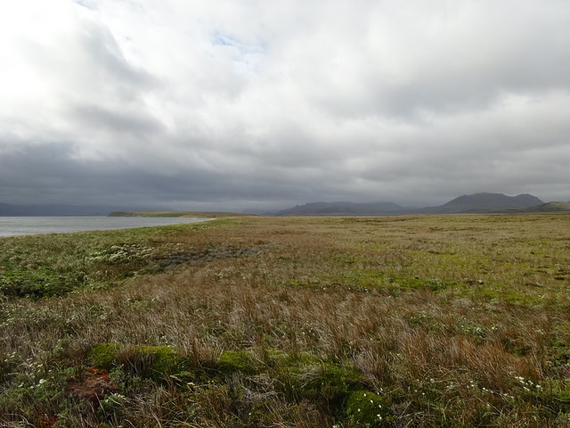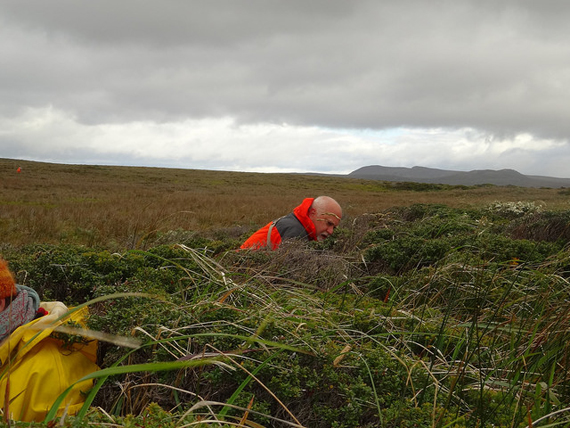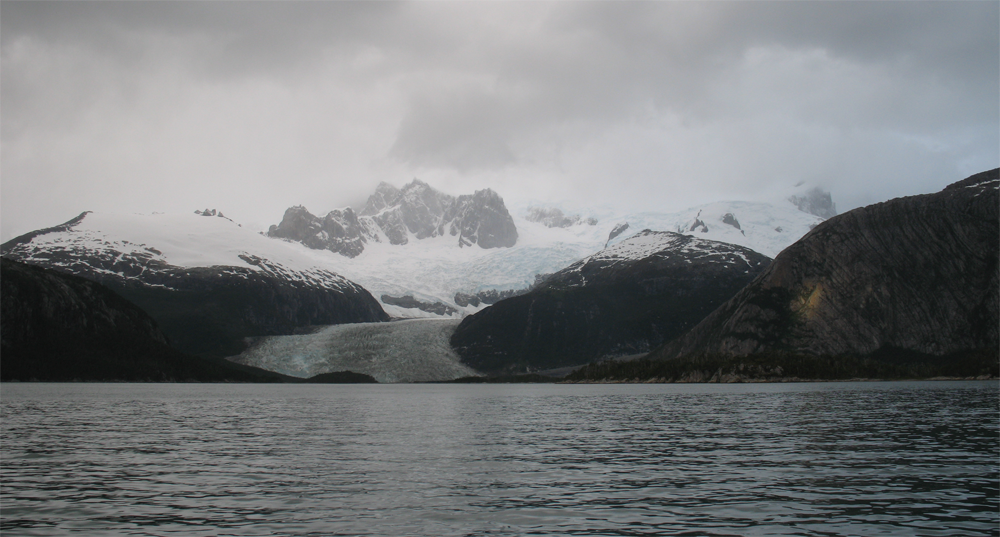From the Field: Bill Buck in Cape Horn 2014, Part 12
Posted in Travelogue on May 9, 2014 by Bill Buck
William R. Buck, Ph.D., is the Mary Flagler Cary Curator of Botany at The New York Botanical Garden. Every January for the last three years, Dr. Buck, a moss specialist, and a team of colleagues have journeyed to the Cape Horn region at the southern tip of South America to document the area’s rich diversity of mosses and search for new species.
January 25, 2014; in transit to Puerto Williams

Two nights ago we pulled into Caleta Antuca (55°42’S, 67°26’W), our final collecting site on Isla Wollaston. We tied off on the rocks and stepped directly ashore. This was fortunate because the wind was blowing strongly and it would have been difficult to get the Zodiac off the deck. Nevertheless, it was a little scary stepping from the rolling ship onto a small rock ledge. Both Barb Andreas and Barbara Murray chose to stay aboard because of this.
The wind howled, but precipitation was minimal. I found mosses around the shore of a lake. From time to time, as I searched around the base of rock ledges, I’d take a brief hiatus from the wind but otherwise gloried in the weather.
In the evening, we trickled back to the ship one by one. Matt von Konrat returned at 8 p.m., and only John Brinda remained in the field. By 8:30 the crew became concerned, and two of them went out to look for our errant collector. As time passed, the worry grew. At 9 p.m., the crew returned empty-handed, leading Juan Larraín and Ernesto Davis—the sturdiest among us—to join in the search.
John finally came wandering back to the ship at 9:15. There was some consternation over his seeming lack of concern, but I retreated rather than saying something I would later regret. Once I had calmed down, I thanked each of the four men who had gone out to search for John. We still had to move the ship to a more sheltered anchorage that night.
We devoted the next day to Isla Grevy, the only large island in the Wollaston-Hermite group that I hadn’t visited. From the moment I saw it, it was clear this island was different. It was low, with no visible peaks or rock outcrops for as far as one could see. Appropriately, the spot where we planned to spend the morning was named “Low Peninsula” (55°35’S, 67°36.5’W).
The wind kept up unabated, and the sea was rough despite clear skies. Whitecaps topped each swell. Veterans from previous years were familiar with this weather and warned newcomers to expect a wet trip ashore. Sure enough, waves and salt spray washed over the small, sturdy Zodiac from the moment we set out. I’m sure I had a grin pasted on my face the entire time. But everyone enjoyed the trip as a novelty, especially those who had spent previous trips huddled on the floor of the Zodiac, trying to keep from being swept overboard.
Barbara saw no rocks upon which Andreaea, the lantern mosses that are her specialty, could possibly grow, so she chose to return to the ship as soon as we reached shore. She later said that, if nothing else, she enjoyed the invigorating Zodiac experience. Rimming the beach was a low heath of Gaultheria, a genus that is a blueberry relative. The plants were about two feet high and difficult to cross. But once we stopped and took a hard look, we found the ground beneath these prickly shrubs—the leaves are sharp-tipped and prone to drawing blood—was carpeted with mosses and, to a lesser extent, liverworts. Finally, we were in a place where mosses predominated over hepatics.

A large Brachythecium species was in abundance, as were mats of Achrophyllum and other species. Beyond the coastal heath, Magellanic tundra dominated the landscape. Seldom have we seen such a flat area that was so extensive. Poking among the shrubs, I found several epiphytic Ulota species, readily collected despite the weaponized Gaultheria leaves protecting them. I think we all returned to the ship satisfied.
As we lunched, the ship moved on to the north coast of Isla Grevy. In a small cove directly south of Punta Dillon (55°30’S, 67°39.5’W), we found a beach of pure mineral sand, little different from those of Florida. This underscored our opinion that Grevy must have had different geological origins than the others in the Wollaston-Hermite group. Numerous fertile Bryum species grew right on the sandy shore, something unseen on the other islands.
At this stop, however, the vegetation was almost impenetrable. Dense shrubs, most of them in the genus Chiliotrichum (in the Asteraceae family), rose to waist height and proved difficult to pass. Behind them was a forest dominated by Maytenus, a tree species usually encountered as scattered individuals. But this forest was so dense that it was almost impossible to enter, and even when an entry point was found, the space proved dark and devoid of mosses and other bryophytes. While I don’t think we found anything jarringly different in our collections here, it was a different suite of species than any previously encountered. By day’s end, we all had far more wet collections than there was dryer space.
This morning’s plan was to hit a quick collecting site on Isla Wollaston between 8 and 10 a.m., then head to Puerto Williams. At 7:15 a.m. I made an executive decision to eliminate this final stop and received no objections, since most of us had been up late the night before. After eating breakfast, I went out on the deck in the falling rain to say goodbye before we got underway.
I love the rugged beauty of the landscape here. I find the architecture of the Nothofagus—the southern beeches—to be one of the most beautiful of all trees. I hope to try growing it from seed in New York. Unlike most, I love the weather here as well. It is unpredictable and often harsh, but these forces of nature are exhilarating. This area has also been good to me, providing a significant grant toward the end of my career.

It felt special to tie up at Isla Wollaston. I first visited this island in 2004, and I’ve had an affection for it ever since. So, with mixed feelings, I said my goodbyes. I knew we still had a few days before we reached Punta Arenas, but Navarino, where we will stop along the way, holds less appeal for me due to its development. As a treat, I have asked that we follow our stop at Puerto Williams with a trip along the northwest arm of the Beagle Channel, swinging into each of the sounds that terminate in glaciers. It will be a nice finale to our work in the region, not as collectors but as tourists.
Before our trip home, however, there is some celebrating to be done. Today is Matt’s 10th wedding anniversary. As a surprise, I have asked the chef to prepare a special dinner, and Ernesto is phoning ahead to Puerto Williams to try to order a cake.
Past Expedition Entries:
Photos provided by Barbara Andreas and Barbara Murray.

